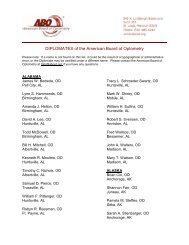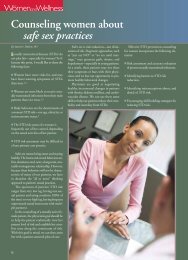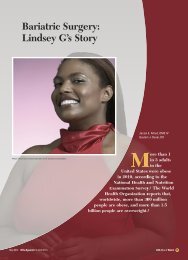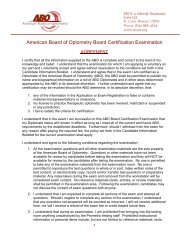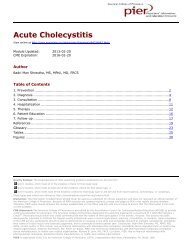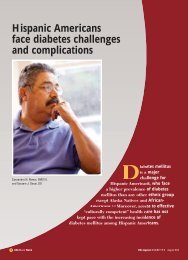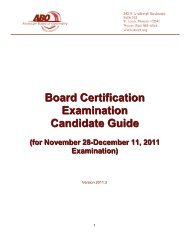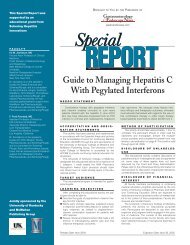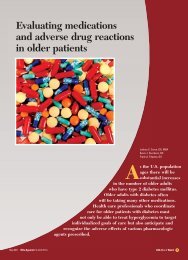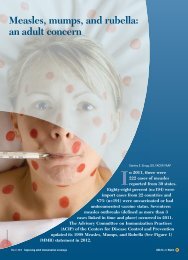OMT for Healthy Aging Menopause and Beyond - CECity
OMT for Healthy Aging Menopause and Beyond - CECity
OMT for Healthy Aging Menopause and Beyond - CECity
You also want an ePaper? Increase the reach of your titles
YUMPU automatically turns print PDFs into web optimized ePapers that Google loves.
Muscle energy or indirect techniques tothe lumbosacral spine could be per<strong>for</strong>medwhile the patient is sitting or st<strong>and</strong>ing.Patient positioning <strong>for</strong> treatment maydepend upon placing her in a com<strong>for</strong>tableposition or using her weight, respiratoryef<strong>for</strong>t <strong>and</strong> posture as adjunctive measures.Such a patient may have a large bodyhabitus that challenges the physician toper<strong>for</strong>m a treatment procedure in a recumbentposition. Or the patient may not beable to breathe lying supine.After somatic dysfunctions of the pelvishave been identified <strong>and</strong> addressed, otherpain or gait problems may be reportedby the patient. While examining the lowerextremities <strong>for</strong> cyanosis, edema, <strong>and</strong> varicosities,the physician can observe gait.Painful gait may be result of plantarfasciitis, flat feet, or somatic dysfunction asevidenced by identification of counterstraintender points on feet, ankles, <strong>and</strong> knees.Posterior fibular head dysfunction aswell as inflammatory arthritis may contributeto genu valgus. Addressing gravitationalstrains <strong>and</strong> muscle imbalances be<strong>for</strong>ereferring the patient <strong>for</strong> orthotic devicesmight relieve pain <strong>and</strong> save money frompurchasing shoes that may be neitherhelpful nor com<strong>for</strong>table.Evaluation of the thoracic spine <strong>and</strong> ribcage may reveal viscerosomatic dysfunction.Compression fractures are commonaround the level of the 8th or 9th thoracicsegments. Digestive complaints such asreflux, hiatal hernia, or eructation may correlatewith joint restriction in the mid tolower thoracic spine.Inability to take deep breaths may bedue to restricted motion of the thorax <strong>and</strong>clavicles. This affects posture <strong>and</strong> upperback pain. Compromised motion of upperribs <strong>and</strong> thoracic spine may cause edema inthe neck <strong>and</strong> upper extremities.Menopausal women often have shoulderpain that may be due to arthritisthat was aggravated by lifting suchheavy items as groceries or gr<strong>and</strong>children.Gentle range of motion techniques ormyofascial stretching may retard shoulderimpingement. Trigger points may uncoverfibromyalgia or areas of referred painof which the cause of upper extremitypain is not limited to the extremity itself.Complaints suggesting carpal tunnelsyndrome may be the result of somatic dysfunctionof interosseous membrane of the<strong>for</strong>earm or of the cervical spine. Structuralevaluation of the cervical spine <strong>and</strong>notation of range of motion help assessthe patient’s ability to turn her head <strong>and</strong>neck in order to per<strong>for</strong>m such simple tasksas backing her auto out of the garageor parking space. Severe arthritis withbone spurring or limited range of motionshould preclude per<strong>for</strong>mance of anytreatment technique that may place thecervical spine in a position of hyper-extensionor hyper-rotation to avoid vertebralartery injury or stroke.Headaches due to muscle contractionwith vascular congestion or increased cervicallordosis may be relieved with treatmentof the occipital-atlantal junction justbeneath the skull. Increased range of motionof this area may also be the result ofmuscle relaxation. While the patient’s head<strong>and</strong> neck are being treated, she may bephysically relaxed enough to discuss psychologicalor emotional stressors whichmay also require her physician’s assistance.Opportunities to incorporate osteopathicmanipulative treatment in healthmanagement plans <strong>for</strong> menopausal womenwho desire to age gracefully have been discussed.Osteopathic physicians can updatetheir skills <strong>and</strong> techniques by attendingcourses offered by state associations, osteopathiccollege post-graduate programming,college of osteopathic family practice, orthe American Academy of Osteopathy.Osteopathic physicians who focus theirpractice on neuromusculoskeletal medicine<strong>and</strong> manipulative medicine can providemore in-depth evaluation <strong>and</strong> treatment ofstructural problems referred to them bycolleagues or other patients. ❙ wwReference1. Ward, R. ed. Foundations <strong>for</strong> OsteopathicMedicine, 2nd ed. 2002. Lippincott,Williams & Wilkins, Philadelphia, Pa.Melicien A. Tettambel, DO, is a fellow of theAmerican Academy of Osteopathy <strong>and</strong> theAmerican College of Osteopathic Obstetricians<strong>and</strong> Gynecologists.20



